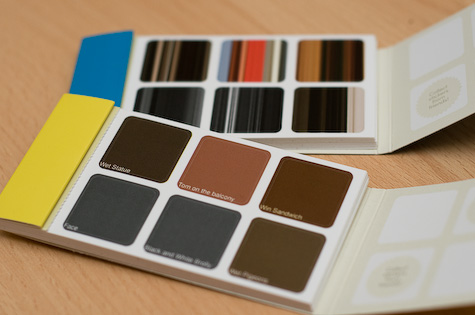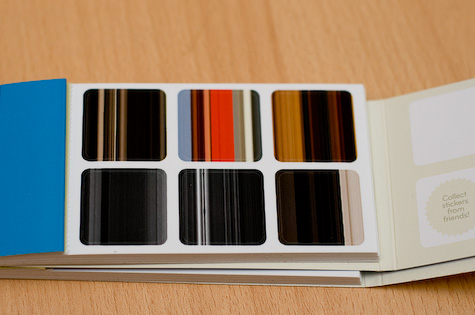-
"So much of design culture is occupied by people that take themselves so very seriously. When thinking about our conversations in the Newsbar about magical realism and surrealism, it became apparent to me that the level of imaginative freedom allowed in the world of experimental fiction, would struggle to exist in contemporary design culture (and academia) because there’d be some form of backlash about how it wasn’t ‘real’… that the work didn’t address the world’s real issues or problems… that it would never succeed in the ‘real world’. We are a discipline that is reliant on our creativity and imagination, but have become terrified of the imaginary."
Stripes and Surrealism: Playing with the Moo API
05 October 2008
Making things is fun. It’s satisfying to watch things spring forth from nothing, made by your own hands.
The greater the gap between your own capabilities (or your perception of them) and your output, the more satisfying – not to mention bemusing – the process is. That’s why Moo‘s public API is so exciting – using nothing but code, you can create real, physical, things. Imagine that! Objects you can hold that sprung forth out of bits and bytes.
I mentioned last week that I’d worked on extending Ruminant, a Ruby library for interfacing with Moo’s API, to also handle the creation of stickers. I wasn’t doing so purely out of generosity, though; I had a project up my sleeve that I wanted to work on.
I can now show you the results of that project. Why only now? Because now, I have the physical products in my hands. I think it’s really important with something like the Moo API that you only talk about what you’ve made when it’s actually real – no showing off code and saying “oh, they’ll be here soon“. You’ve got to make the things.
Anyhow: now I can tell you what I was up to.

These are two books of stickers, made from of my most recent photos on Flickr. They’re built by taking data from the Flickr API, processing it on my computer, uploading it to the web, and sending it to Moo’s API. This is a single shell command. You fill out a configuration file with the important details – such as your API keys for both Moo and Flickr – and run the file. A short while later, you’ll be asked to pay for your stickers, and off you go.
The fun part of this isn’t the whole one-step thing; it’s what goes on when we process the images. We don’t just print them straight, you see.
Another short aside: making real things out of code is fun because you don’t think it should be possible, and image-processing is actually similarly entertaining, just because it feels like it should be harder than it is. Most “easy” programming comes down to processing text in, and text out. Images seem like they should be harder. In fact, images are now much easier than they used to be thanks to things like GD and ImageMagick. I had a lot of fun playing with RMagick, and it wasn’t difficult at all.
So, what did I make?

The first are what I called Dadaist Photographs. Moo stickers are small; it’s quite hard to see a proper photo on their small dimensions. So why not make something at once very vague, and yet also entirely precise? That’s what these are. The background of the image is the average colour of the photo, determined by summing the red, green, and blue values of each pixel in the image, and then dividing each of those by the area of the image to get the average red, green, and blue values – and then making a colour out of those. In the foreground, we super-impose the title of the photograph in text. This is, as you can tell, somewhat silly. But! It’s a hyper-realistic single-pixel photograph, and ideal for Moo’s stickers. (A quick note – I didn’t quite add enough padding to the text on these. I’ve learned my lesson for next time).
Whilst I was working on that, I had another fun idea. It turned out to be just as easy to build, as it resuses most of the same code as the Dadaist Photographs. This let me abstract lots of things out, and at the same time learn how to write slightly tidier object-oriented Ruby. Anyhow, a short while later, and we had these:

These are less silly, and to my mind more beautiful – they render wonderfully on paper. They are very simple to make. First, we squash the photo down to being a 500×500 square. Then, we take the middle row of pixels in the image, and replace every row of pixels in the image with the middle row. The net result is essentially a “stretched” image, based on a single row from the image. RMagick made this very easy. Like I said, I think the results are very beautiful, and it’s amazing how easily identifiable they all are.
I wrote these by first creating the image processing code. That’s the stuff I was least familiar with, and took the longest to get my head around. Once that was done, it was relatively easy to bolt proper Flickr API import on (thanks to the Net::Flickr gem), and subsequently take my processed images and throw them directly at Moo’s API, thanks to Ruminant. A small amount of tidying, abstraction, and the creation of simple config files later, and we were done.
The only slight catch is that Moo need to get pictures from the public web. I’m running my script locally, because it’s quite processor/memory intensive, so the script SFTPs the pictures to a destination of your choosing before sending them to Moo.
But that’s it. It’s one click. It works most of the time (but with 90 images sometimes chokes a little; still, it’s not hard to salvage that by generating the XML for the order yourself). Because of the processor/memory overhead on rendering the images, I haven’t put this online as a web tool – I’m still thinking if there’s an easy way to do that. This could end up on EC2 one day.
What I’ve done instead is to put it on github, so you can at least see the code to learn from it, and, if you want, download and run your own copy. (If you’re not sure what to do: install git, and then click “clone” on the github page to get the command to type to clone the repository), I can’t guarantee it’ll work on your machine, and I can’t offer any support to help you get it running, but I hope you have fun with it regardless.
So there you go. First, an idea; then, the physical product; finally, the code that makes it all work. This doesn’t serve much real purpose, I’ll admit, but it was a fun making project, and it’s hugely satisfying to see how easy it is to make things out of pictures and paper with code, starting with a simple idea.
I’m not sure if I’ll take this any further – it stands alone quite nicely – but for starters, I’m going to see if I can extend Ruminant to handle other product types – though for various reasons, that might take a little while. If I do anything with it, you’ll hear it here first. In the meantime, I hope this serves as a little inspiration for how easy it is to make fun stuff with Moo, and perhaps that my silly, surreal stickers raised a smile.
-
"So we decided to treat Availabot as a world probe: it was decided that we would take Availabot through to the position of being factory ready, and in the process learn as much as possible about the processes of manufacture, and how to develop these kind of complex products with so many moving parts." And, best news of all: Availabot will be coming to market. Excellent.
-
"…this leads up to a discussion of two things: the OAuth protocol which aims, amongst other laudable goals, to help safeguard users’ passwords, and the distinctly unnerving trend which Jeremy Keith has christened the password anti-pattern, which really doesn’t." A clear, articulate explanation of the issues around authentication.
-
In 2000, a group of seventh-graders were asked to draw what they thought scientists looked like and describe their pictures. Then, after visting Fermilab, they were asked to repeat the exercise. Some of the quotations are genuinely excellent, cf "Some people think that (scientists) are just some genius nerds in white coats, but they are actually people who are trying to live up to their dreams and learn more." Aren't we all?
-
"At GDC 2006 Sony’s Lead Programmer – Tim Moss had talk titled “God of War: How the Left and Right Brain Learned to Love One Another”. I read it, remembered mainly that it was interesting they had used Maya as main tool and kinda forgot about it. Only recently I’ve found out that recording from this session has been made available (for free) as well. You can download it here. Combined together they’re really interesting and I recommend everyone to spend few minutes and listen to it while reading slides." Some interesting stuff – God of War pre-scripts a lot of things that other people might want to do in real time, and as such, makes some stuff simpler, and makes controlling the players' experience easier.
-
A detailed look at various techniques for greebling Lego models.
-
"To me, these bizarre sequences represent adaptations of classical Brechtian stagecraft to video games. The way we interact with a game is different than the way we interact with a staged fiction, and by manipulating the tools specific to game-interaction– the interface and the mission-delivery system– Kojima delivers that sense of alienating weirdness that's the hallmark of the Verfremdungseffekt." I like Pliskin's commentary here – the absurdity of Arsenal Gear was great, and much preferable to the boss-rush that followed it.
-
"The dissertation builds on available sociological approaches to understanding everyday life in the networked city to show that emergent technologies reshape our experiences of spatiality, temporality and embodiment. It contributes to methodological innovation through the use of data bricolage and research blogging 1, which are presented through experimental and recombinant textual strategies; and it contributes to the field of science and technology studies by bringing together actor-network theory with the sociology of expectations in order to empirically evaluate an area of cutting-edge design." Anne Galloway's PhD thesis, now online.
-
A remake of "You Have To Burn The Rope", in the style of an Intellivision game. They've changed an important play mechanic and given the game an entertaining twist ending. Fun.